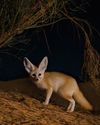DUNE BUGS
BBC Wildlife
|August 2021
Corrugated sand spanning some 20km fringes the Sefton Coast in Merseyside. It’s the UK’s largest undeveloped dune system – bustling with rare insects, reptiles and amphibians – and is the focus of a major conservation project.

At first glance, sand can seem a harsh, inhospitable environment – yet dunes are teeming with life. Those flanking the Sefton Coast host a diverse community of rare and beautiful species, including this iridescent northern dune tiger beetle photographed by Alex Hyde while documenting the Gems in the Dunes project, part of the wider Back from the Brink conservation programme. “These ultra-predators are just berserk – speedy and tricky to photograph,” he recalls. “They’ll charge anything that moves.” Habitat restoration work at Sefton – home to Britain’s largest northern dune tiger beetle population – included the creation of open sand patches for such animals to bask on and burrow in.

The setting sun gilds the grasses crowning Sefton’s dunes, signalling a changing of the guard: diurnal species retreat into burrows, while their nocturnal counterparts emerge to feed and mate. “Each morning, little half-moon holes in the slopes reveal where tiger beetles left their burrows,” says Alex, “and tiny tracks spidering the dunes – footprints of insects, sand lizards, natterjack toads – write stories into the sand.” Protection of this habitat, much of which has been destroyed across Britain, is vital; on the Sefton Coast alone, some 81 per cent of bare sand has gone since 1945.

Denne historien er fra August 2021-utgaven av BBC Wildlife.
Abonner på Magzter GOLD for å få tilgang til tusenvis av kuraterte premiumhistorier og over 9000 magasiner og aviser.
Allerede abonnent? Logg på
FLERE HISTORIER FRA BBC Wildlife

BBC Wildlife
"I was terrified the elephant would ram us"
African elephant in Kenya
2 mins
January 2026

BBC Wildlife
ALL YOU EVER NEEDED TO KNOW ABOUT THE Fennec fox
THE FENNEC FOX IS THE SMALLEST fox in the world, with a body length that can be as little as 24cm.
3 mins
January 2026

BBC Wildlife
INTO THE PLASTISPHERE
A unique synthetic ecosystem is evolving in our oceans – welcome to the plastisphere
7 mins
January 2026

BBC Wildlife
“More than half of all animal life exists in a parasitic relationship, and all life lives in symbiosis”
Our survival depends on species evolving to live together - but some relationships take dark turns
7 mins
January 2026

BBC Wildlife
Are animals able to dream?
SLEEP IS A MYSTERIOUS THING. FOR A long time, we weren't sure why we do it.
1 mins
January 2026

BBC Wildlife
Does a cuckoo know it's a cuckoo?
ABSURD LITTLE BIRDS ACROSS THE world lay their eggs in the nests of other species, leaving the hapless parents to raise a changeling at the expense of their own offspring.
2 mins
January 2026

BBC Wildlife
Orcas killing young sharks
Juvenile great whites are easy prey for orca pod
1 mins
January 2026

BBC Wildlife
Ocean goes on tour
Acclaimed film touring the UK, backed by live orchestra and choir
1 min
January 2026

BBC Wildlife
Feisty bats hunt like lions
Winged mammals use a 'hang and wait' strategy to take down large prey
1 mins
January 2026

BBC Wildlife
SNAP-CHAT
Richard Birchett on magical merlins, wily coyotes and charging deer
2 mins
January 2026
Translate
Change font size

